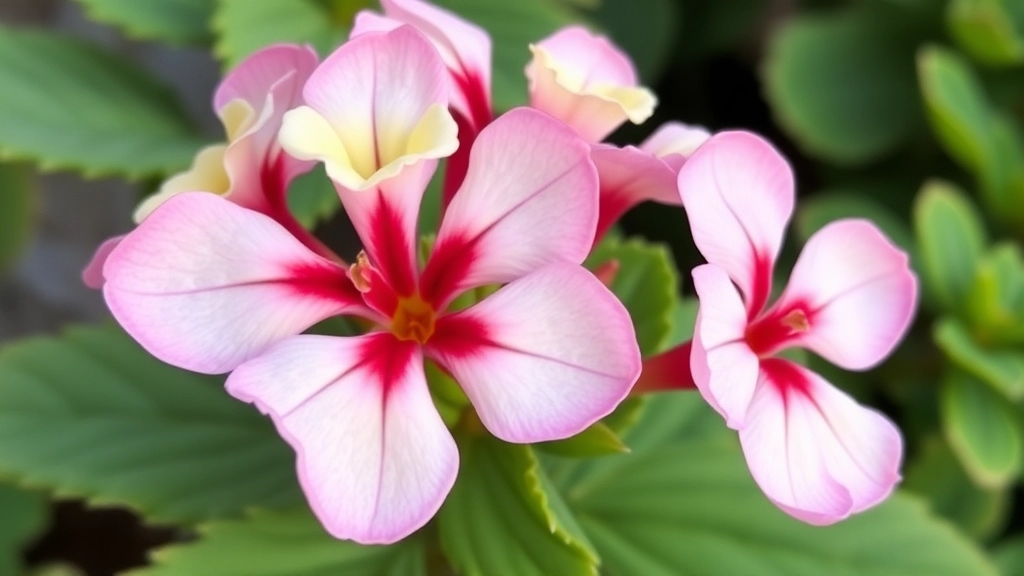Kalanchoe Blossfeldiana Hybrid: A Gardener’s Delight
If you’re a plant enthusiast like me, you’ve probably come across the stunning Kalanchoe Blossfeldiana Hybrid. These vibrant succulents are not only visually appealing but also relatively easy to care for, making them a favourite among indoor gardeners. In this article, we’ll dive into the popular varieties, optimal growing conditions, and creative uses for these hybrids, ensuring you have all the information needed to make your Kalanchoe thrive.
Understanding Kalanchoe Varieties
Understanding the unique characteristics of each Kalanchoe Blossfeldiana Hybrid variety can significantly enhance your gardening experience. We’ll explore the best propagation techniques, indoor and outdoor care tips, and how to tackle common pests and diseases. Whether you’re a seasoned gardener or a newbie, this guide will provide practical insights to help you enjoy the full beauty of your Kalanchoe Blossfeldiana Hybrid.
When exploring the world of Kalanchoe Blossfeldiana hybrids, you might wonder which varieties stand out for their beauty and ease of care.
Kalanchoe hybrids are renowned for their vibrant blooms and adaptability, making them a popular choice among plant enthusiasts.
Key Varieties to Consider:
- Kalanchoe ‘Calandiva’: Known for its double blooms, Calandiva offers a lush, full appearance. It comes in various colours, including red, pink, and white.
- Kalanchoe ‘Flapjack’: This variety features thick, succulent leaves that display a stunning red edge when exposed to sunlight. Its unique foliage adds a touch of flair beyond just flowers.
- Kalanchoe ‘Chandelier’: With its cascading growth habit, this hybrid is perfect for hanging baskets. The delicate flowers create a beautiful waterfall effect.
- Kalanchoe ‘Thyrsiflora’: Also known as the ‘Paddle Plant’, this variety has rosettes of leaves and produces tall flower spikes, adding height to your plant display.
- Kalanchoe ‘Pink Butterflies’: This charming variety features soft pink blooms that resemble butterflies, making it a delightful addition to any indoor garden.
These varieties not only bring colour to your space but also offer a range of growing experiences.
Optimal Growing Conditions for Kalanchoe Hybrids
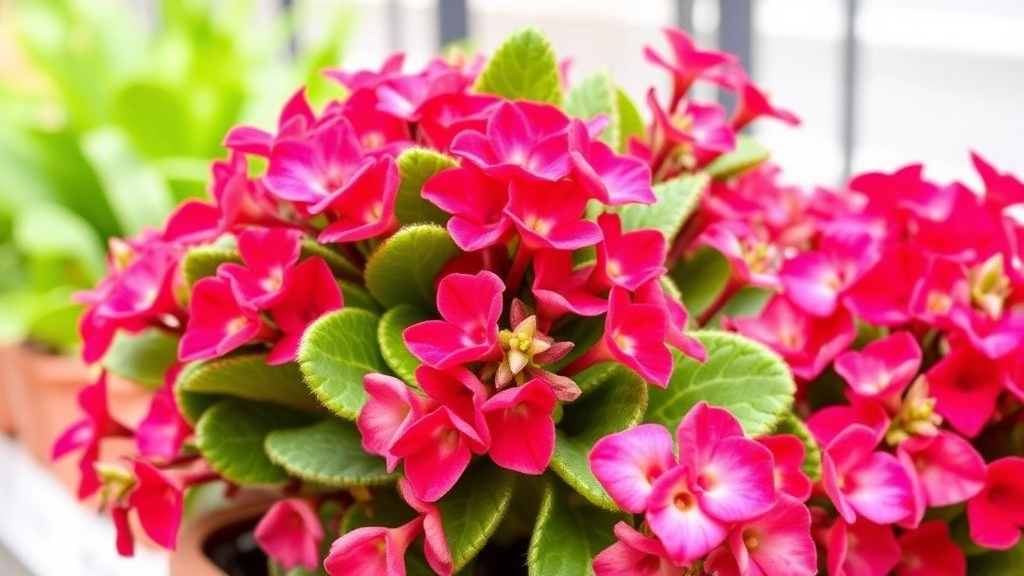
So, you’ve got your Kalanchoe Blossfeldiana hybrids, and you’re wondering how to help them thrive?
Let’s dive into the optimal growing conditions that will keep your plants happy and blooming.
Light Requirements
Kalanchoe hybrids love bright, indirect sunlight.
- Ideal Spot: A south or west-facing window is perfect.
- Avoid Direct Sun: Too much direct sunlight can scorch their leaves.
Temperature Preferences
These beauties prefer a warm environment.
- Optimal Range: Keep them between 20-25°C (68-77°F) during the day.
- Nighttime Chill: They can tolerate cooler nights, but avoid dropping below 10°C (50°F).
Watering Needs
Watering can be a bit tricky, but here’s the scoop:
- Soil Check: Always check if the top inch of soil is dry before watering.
- Frequency: Typically, every 2-3 weeks is good, but adjust based on humidity and temperature.
Soil Type
The right soil makes a world of difference.
- Well-Draining Mix: Use a cactus or succulent mix.
- DIY Option: Mix regular potting soil with sand or perlite for better drainage.
Humidity Levels
Kalanchoe hybrids are not fussy about humidity.
- Ideal Range: They thrive in average household humidity.
- Extra Care: If your home is very dry, consider misting occasionally.
Fertilisation
Feed them to keep the blooms coming.
- Frequency: During the growing season (spring and summer), feed them once a month with a balanced, water-soluble fertiliser.
- Dilution: Always dilute the fertiliser to half-strength to avoid burning the roots.
Propagation Techniques for Kalanchoe Blossfeldiana
Are you looking to expand your collection of Kalanchoe Blossfeldiana hybrids? Propagation is not only rewarding but also an excellent way to share these stunning plants with friends and family.
1. Leaf Cuttings
One of the most straightforward methods is through leaf cuttings. Here’s how to do it:
- Select a Healthy Leaf: Choose a mature leaf from a healthy plant.
- Cut the Leaf: Use a clean, sharp knife to cut the leaf at the base.
- Allow to Callous: Place the leaf in a dry area for a day or two to allow the cut end to callous over.
- Planting: Once calloused, place the leaf in well-draining soil, burying just the cut end.
- Water Sparingly: Mist the soil lightly and keep it slightly moist but not soggy.
2. Offsets
Kalanchoe plants often produce offsets, or “pups,” which are baby plants that can be separated and planted. Here’s how to propagate using offsets:
- Identify Offsets: Look for small plants growing around the base of the parent plant.
- Gently Separate: Carefully remove the offset, ensuring it has some roots attached.
- Replant: Place the offset in a small pot with well-draining soil.
- Care: Water lightly and provide indirect sunlight.
3. Stem Cuttings
Stem cuttings are another effective way to propagate Kalanchoe. Here’s the process:
- Choose a Healthy Stem: Select a stem with several leaves.
- Cut the Stem: Use a clean knife to cut a 4-6 inch section from the stem.
- Callous Over: Let the cut end dry for a few hours or overnight.
- Planting: Insert the cut end into well-draining soil and water lightly.
- Light and Care: Place in bright, indirect light and keep the soil slightly moist.
4. Seed Propagation
While less common, you can also propagate Kalanchoe from seeds:
- Obtain Seeds: Purchase seeds from a reputable supplier.
- Prepare Soil: Use a seed-starting mix in a shallow tray.
- Sow Seeds: Sprinkle seeds on the surface and lightly press them into the soil.
- Moisture: Mist the soil to keep it moist but not wet.
- Light: Place the tray in a warm area with indirect sunlight.
Creative Indoor Uses for Kalanchoe Blossfeldiana
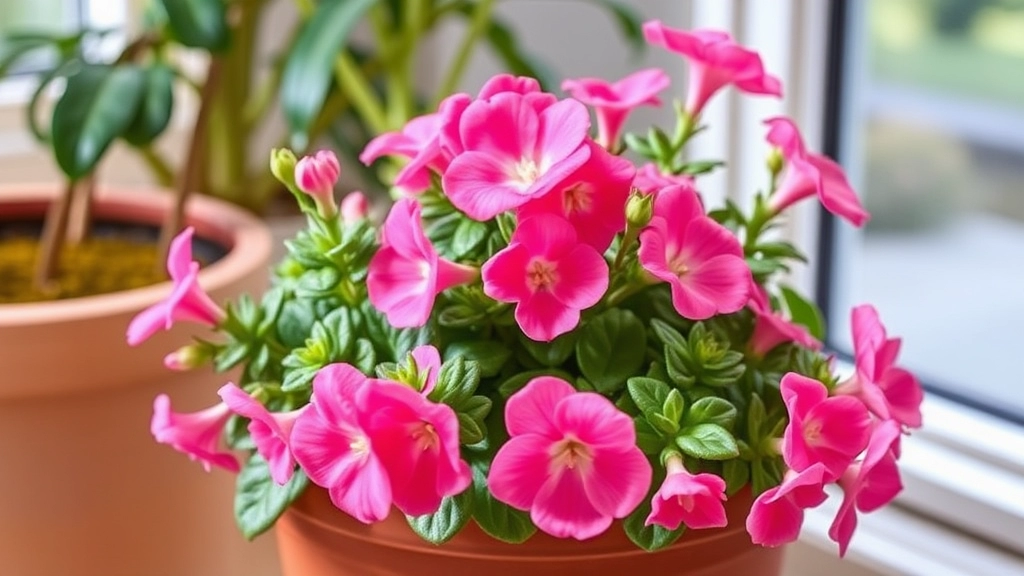
As we explore the versatility of Kalanchoe Blossfeldiana, it’s essential to consider how these vibrant plants can enhance our indoor spaces. Many of us wonder how to incorporate such beautiful blooms into our homes effectively.
1. Stunning Centrepieces
Kalanchoe hybrids make for eye-catching centrepieces on dining tables or coffee tables.
- Mix and Match: Combine different colours and sizes for a dynamic look.
- Seasonal Themes: Use them to reflect seasonal changes, such as bright reds for winter holidays or pastels for spring.
2. Brightening Up Workspaces
Adding Kalanchoe to your workspace can boost your mood and productivity.
- Desk Decor: A small pot of Kalanchoe can add a splash of colour to an otherwise dull desk.
- Air Quality: These plants can help improve air quality, making your work environment healthier.
3. Decorative Shelves and Windowsills
Kalanchoe hybrids thrive in bright, indirect light, making them perfect for shelves and windowsills.
- Layering Heights: Use plant stands or varying pot heights to create visual interest.
- Group Planting: Combine Kalanchoe with other houseplants for a lush indoor garden feel.
4. Gift Ideas
Kalanchoe Blossfeldiana hybrids are excellent gifts for various occasions.
- Housewarming: A potted Kalanchoe can be a thoughtful housewarming gift.
- Celebrations: They can also be used to celebrate birthdays or anniversaries.
5. Unique Wall Displays
Consider creating a vertical garden with Kalanchoe hybrids.
- Wall Planters: Use wall-mounted planters to showcase these plants creatively.
- Artistic Arrangements: Mix Kalanchoe with other succulents for a more textured look.
Outdoor Care Tips for Kalanchoe Hybrids
When it comes to nurturing Kalanchoe hybrids outdoors, understanding their specific needs can make all the difference. Many gardeners worry about how to provide the ideal environment for these vibrant plants.
Optimal Sunlight Exposure
Kalanchoe hybrids thrive in bright, indirect sunlight. Here are some tips:
- Location: Choose a spot that receives at least 6 hours of sunlight daily.
- Shade: If your area experiences intense afternoon sun, consider providing some shade to prevent leaf scorch.
Watering Practices
One of the most common concerns is watering. Overwatering can lead to root rot, while underwatering may cause wilting.
- Frequency: Water every 2-3 weeks during the growing season, allowing the soil to dry out between waterings.
- Technique: Ensure water drains well; avoid letting the pot sit in standing water.
Soil Requirements
The right soil is crucial for healthy Kalanchoe hybrids.
- Type: Use a well-draining cactus or succulent mix.
- pH Level: Aim for a slightly acidic to neutral pH (around 6.0 to 7.0).
Temperature and Humidity
Kalanchoe hybrids prefer warm conditions.
- Temperature: Keep them in temperatures between 20°C to 30°C.
- Humidity: They thrive in low to moderate humidity levels, making them perfect for most outdoor settings.
Fertilisation
Feeding your Kalanchoe hybrids can boost their growth and flowering.
- Type: Use a balanced, diluted liquid fertiliser during the growing season.
- Frequency: Apply every 4-6 weeks for optimal results.
Common Pests and Diseases Affecting Kalanchoe Hybrids
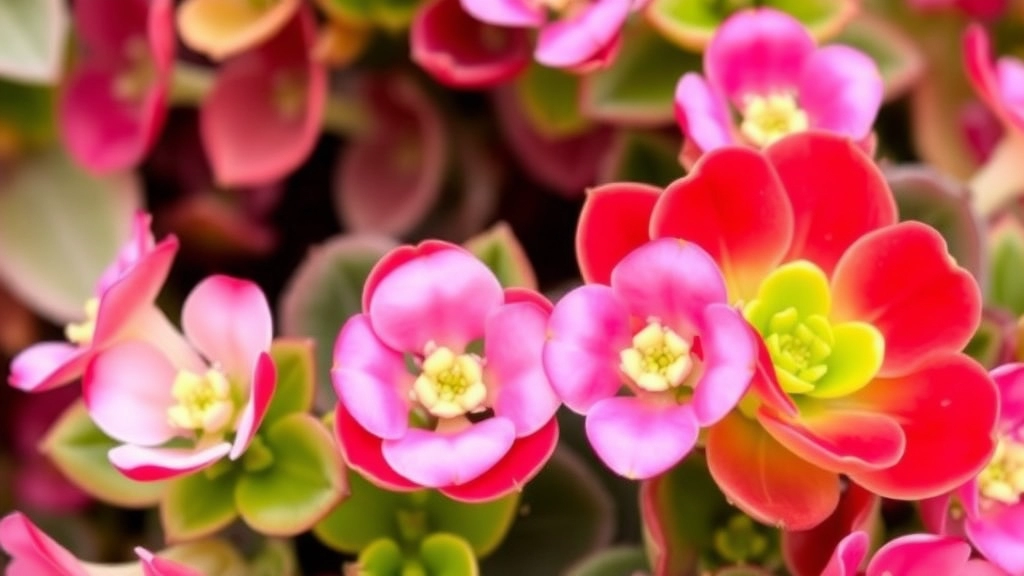
Have you ever noticed your Kalanchoe looking a bit off? Maybe the leaves are curling or there are tiny bugs lurking around. You’re not alone! Many plant lovers face the same issues with these beautiful hybrids.
Common Pests:
- Mealybugs
- These little white critters love to hide in the leaf joints.
- They suck the sap, causing yellowing leaves.
- Tip: Wipe them off with a cotton swab dipped in rubbing alcohol.
- Spider Mites
- Tiny and hard to see, they leave fine webbing on your plants.
- Affected plants may appear dusty and have stippled leaves.
- Tip: Increase humidity around the plant to deter them.
- Aphids
- These green or black bugs cluster on new growth.
- They can stunt growth and cause leaves to curl.
- Tip: Spray with insecticidal soap or neem oil for a quick fix.
Common Diseases:
- Powdery Mildew
- This fungal disease looks like a white powder on leaves.
- It thrives in high humidity and poor air circulation.
- Tip: Ensure good airflow and avoid overhead watering.
- Root Rot
- Overwatering can lead to mushy roots and wilting plants.
- Tip: Always use well-draining soil and pots with drainage holes.
- Leaf Spot
- Dark spots on leaves are usually a sign of fungal infection.
- They can spread quickly if not treated.
- Tip: Remove affected leaves and avoid wetting the foliage.
Safety Concerns for Pets and Humans
When considering the beauty of Kalanchoe Blossfeldiana hybrids, it’s crucial to address safety concerns for both pets and humans. Many plant enthusiasts may not be aware that certain varieties can pose risks.
Risks to Pets
Kalanchoe hybrids are known to be toxic to pets, particularly cats and dogs. The ingestion of any part of the plant can lead to symptoms such as:
- Vomiting
- Diarrhoea
- Lethargy
- Abdominal pain
If you suspect your pet has ingested Kalanchoe, it’s essential to consult your veterinarian immediately. Keeping plants out of reach is a practical step to prevent accidental ingestion.
Risks to Humans
While Kalanchoe is not typically harmful to humans, certain individuals may experience mild skin irritation upon contact with the sap. Symptoms can include:
- Redness
- Itching
- Rash
It’s wise to wear gloves when handling the plant and wash your hands thoroughly afterward.
Best Practices for Safety
To ensure a safe environment for both pets and humans, consider these tips:
- Placement: Keep Kalanchoe plants on high shelves or in rooms that are off-limits to pets.
- Education: Familiarise family members with the plant’s potential hazards.
- Monitoring: Regularly check for any signs of irritation in both pets and humans after handling the plant.
By taking these precautions, you can enjoy the vibrant blooms of Kalanchoe hybrids without worry.
Pruning and Maintenance for Prolonged Blooming
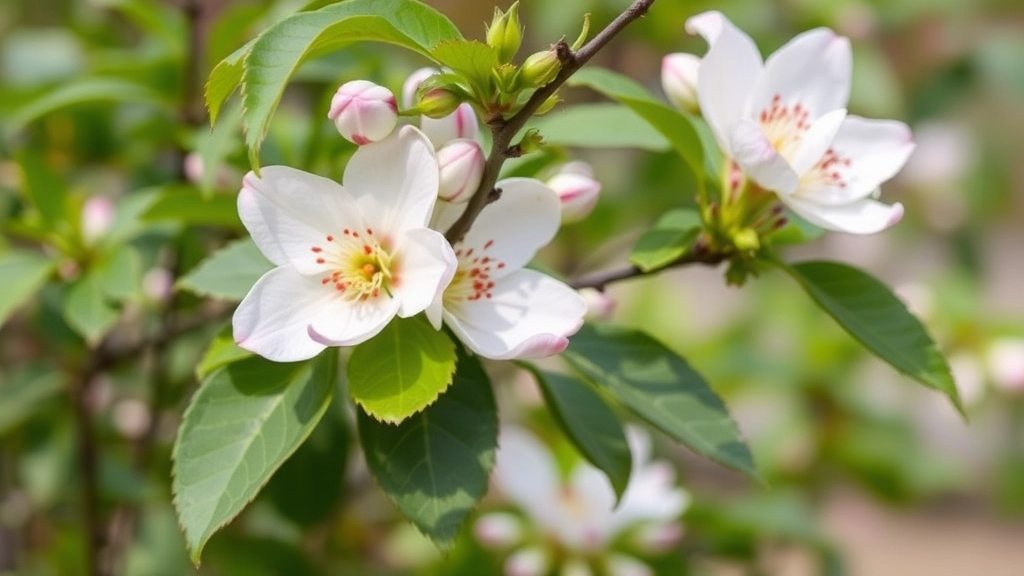
Ever wondered how to keep your Kalanchoe Blossfeldiana blooming beautifully for longer?
Pruning and maintenance are key players in this game.
Why Prune?
- Promotes healthy growth.
- Encourages more blooms.
- Keeps the plant looking tidy.
When to Prune?
- Right after the blooming season.
- Remove spent flowers to prevent seed formation.
How to Prune?
- Gather Your Tools: A clean pair of scissors or pruning shears.
- Identify Dead or Wilted Leaves: Snip them off at the base.
- Cut Back Stems: Trim them to about a third of their height, focusing on leggy growth.
- Shape the Plant: Aim for a rounded shape to encourage fullness.
Maintenance Tips
- Watering: Allow the soil to dry out between waterings. Overwatering can lead to rot.
- Light: Place your Kalanchoe in a bright spot, but avoid direct sunlight that could scorch the leaves.
- Fertilizing: Use a balanced fertiliser every few weeks during the growing season.
By keeping up with these pruning and maintenance tips, you’ll not only extend the blooming period but also keep your Kalanchoe looking vibrant and healthy.
Seasonal Flowering and Re-blooming Strategies for Kalanchoe Blossfeldiana
As we explore the vibrant world of Kalanchoe Blossfeldiana, it’s essential to understand how to encourage seasonal flowering and re-blooming. Many enthusiasts often wonder why their plants stop blooming or how to coax them into another round of flowers.
Understanding Flowering Cycles
Kalanchoe Blossfeldiana typically follows a specific flowering cycle influenced by light and temperature. To ensure your plant blooms beautifully, consider the following strategies:
- Light Exposure: Kalanchoe thrives in bright, indirect sunlight. Aim for 12-14 hours of light daily, especially during the growing season. A sunny windowsill is ideal.
- Temperature Control: Maintain a temperature range of 15-25°C (59-77°F). Sudden temperature changes can stress the plant, affecting its blooming potential.
- Watering Routine: Allow the soil to dry out between waterings. Overwatering can lead to root rot, while underwatering can cause stress, both of which hinder flowering.
Encouraging Re-blooming
Once your Kalanchoe has finished its initial bloom, you may wonder how to encourage it to flower again. Here are some effective tips:
- Pruning: After flowering, cut back the spent blooms and any leggy growth. This encourages new growth and can lead to more flowers.
- Fertilisation: Use a balanced, water-soluble fertiliser every four to six weeks during the growing season. A high phosphorus content promotes blooming.
- Rest Period: Allow your Kalanchoe a rest period of about six weeks after blooming. Reduce watering and stop fertilising to give the plant time to recuperate.
Timing for Optimal Results
Timing is crucial for seasonal flowering. Here’s a quick guide:
- Spring: Ideal for planting and initial blooming.
- Summer: Continue care; this is when the plant strengthens.
- Autumn: Prepare for a rest period. Adjust light exposure to encourage budding.
- Winter: With proper care, your Kalanchoe can surprise you with blooms even in the colder months.
FAQs on Kalanchoe Blossfeldiana Hybrids
What are the optimal light conditions for Kalanchoe hybrids?
Kalanchoe hybrids thrive in bright, indirect sunlight. A south or west-facing window is ideal, but avoid direct sunlight as it can scorch their leaves.
What temperature range is best for Kalanchoe Blossfeldiana hybrids?
These plants prefer a warm environment with daytime temperatures between 20-25°C (68-77°F). They can tolerate cooler nights but should not be exposed to temperatures below 10°C (50°F).
How often should I water my Kalanchoe hybrids?
Watering should be done every 2-3 weeks, but always check if the top inch of soil is dry before watering. Adjust the frequency based on your home’s humidity and temperature.
What type of soil is best for Kalanchoe hybrids?
Use a well-draining mix, such as cactus or succulent soil. You can also mix regular potting soil with sand or perlite to improve drainage.
Do Kalanchoe hybrids need high humidity?
No, they thrive in average household humidity. If your home is very dry, occasional misting can help.
How often should I fertilize my Kalanchoe hybrids?
During the growing season (spring and summer), fertilize once a month with a balanced, water-soluble fertilizer diluted to half-strength to avoid burning the roots.
How can I use Kalanchoe hybrids creatively indoors?
These plants make stunning centerpieces, brighten up workspaces, and look great on decorative shelves and windowsills. They also make excellent gifts and can be used in unique wall displays.
What are common pests that affect Kalanchoe hybrids?
Common pests include mealybugs, spider mites, and aphids. Mealybugs can be removed with a cotton swab dipped in rubbing alcohol. Increase humidity to deter spider mites, and use insecticidal soap or neem oil for aphids.
What diseases are Kalanchoe hybrids susceptible to?
Common diseases include powdery mildew, root rot, and leaf spot. Ensure good airflow and avoid overhead watering to prevent powdery mildew. Use well-draining soil to prevent root rot, and remove affected leaves to control leaf spot.
Why is pruning important for Kalanchoe hybrids?
Pruning promotes healthy growth, encourages more blooms, and keeps the plant looking tidy. It’s best done right after the blooming season and involves removing spent flowers and cutting back leggy growth.
How should I prune my Kalanchoe hybrids?
Use clean scissors or pruning shears to snip off dead or wilted leaves at the base. Trim stems to about a third of their height, focusing on leggy growth, and shape the plant to encourage fullness.
What are some maintenance tips for Kalanchoe hybrids?
Allow the soil to dry out between waterings to prevent rot. Place the plant in a bright spot but avoid direct sunlight. Fertilize every few weeks during the growing season with a balanced fertilizer.
References
-
Kalanchoe Blossfeldiana Growing Guide – Gardeners’ World
-
How to Grow Kalanchoe Indoors – The Spruce
-
Kalanchoe: How to Grow and Care for Kalanchoe Plants – The Old Farmer’s Almanac
